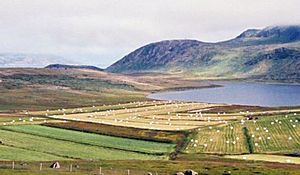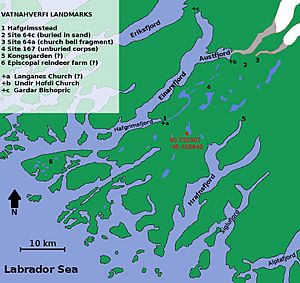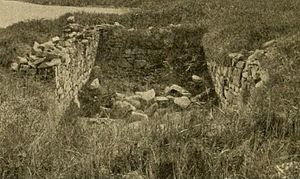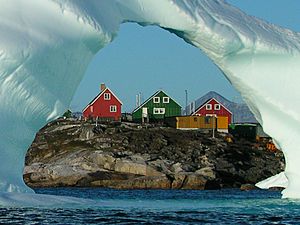Vatnahverfi facts for kids
Vatnahverfi was an important area in Norse Greenland. It was part of the Eastern Settlement (Eystribyggð), where Norse people lived. Experts believe it had the best land for raising animals in the whole colony. The Norse settled Vatnahverfi in the late 10th century. They farmed there for almost 500 years. Then, they mysteriously disappeared from the area and all of Greenland, likely in the late 1400s. The name "Vatnahverfi" means "Lake District."
Contents
Where Was Vatnahverfi Located?
Vatnahverfi was on the southwest coast of Greenland. It was like a long piece of land (a peninsula) that stretched northeast. It went from the Labrador Sea to the Jespersens Glacier, about 60 kilometers (37 miles) inland. The area covered about 500 square kilometers (193 square miles).
It was located between two fjords: Einarsfjord (now called Igaliku) and Hrafnsfjord (now called Agdluitsoq). The center of Vatnahverfi was about 140 kilometers (87 miles) northwest of Greenland's southern tip, Cape Farewell.
How Did the Norse Settle Vatnahverfi?
The first Norse settlers arrived in Vatnahverfi with Erik the Red. This was around 985 AD, when many people left Iceland to settle in Greenland. The Saga of the Greenlanders says that Erik's companions claimed land in Greenland. One man, Hafgrim, claimed "Hafgrímsfjörð and Vatnahverfi." The Landnámabók (Book of Settlements) tells a similar story.
Erik and his people often built their homes away from the sea. They preferred the inner parts of the fjords. Here, the weather was milder, and the land was better for farming and raising animals. This was also true in Vatnahverfi. Most farms were in the northern part of the peninsula. They were 30 kilometers (19 miles) or more from the ocean. However, the fjords still gave them easy access to the sea.
What made Vatnahverfi a bit different was that many farms were also built near lakes and rivers. In other areas, farms were mostly just along the fjords. Archaeologists have found the remains of 50 Norse farms in Vatnahverfi. This is about 10% of all known farms in the Eastern Settlement. At its busiest time, Vatnahverfi likely had about 500 people. This is based on an average of 8 to 10 people per farm.
Important Farm Areas
The largest group of farms in Vatnahverfi was between Hafgrimsfjord and Austfjord. These fjords were branches of Einarsfjord. Hafgrim himself probably settled at the end of Hafgrimsfjord. You can still see the ruins of a large farm there. He and his family were likely the leaders of the area. This farm also had a small church. Some believe it was the Langanes church mentioned in the Saga of Einar Sokkeson. Today, the Inuit people call this area Eqaluit, which means "salmon-place."
Another important area was near the end of Austfjord. This is now called Sondre Igaliku or Igaliku Kujalleq. It was important because it was close to Gardar. Gardar was about 15 kilometers (9 miles) away. It was where the colony's bishop lived and where the Althing (parliament) met. Austfjord also had a small church called Undir Hofdi.
Archaeologists found a piece of melted clay and glass at the church ruins. This suggests the church might have been burned down. Other larger churches in Brattahlid, Gardar, and Herjolfsnes might have also burned.
The farms in Vatnahverfi seemed to be very successful. Digs by archaeologists show that the Norse settlers raised cattle, sheep, goats, and pigs. They also kept horses and dogs. The Norwegian king owned a large property called Kongsgarden. It was at the end of Hrafnsfjord, in an area called Foss (waterfalls). This place was known for its many salmon.
Vatnahverfi in Old Stories
Vatnahverfi is mentioned in the Greenlander's Saga and Landnámabók. It was also likely the place where an event from the Saga of Einar Sokkeson happened. In that story, Einar killed a Norwegian merchant during a feast. The Bishop Arnold seemed to approve of this.
A Norwegian priest named Ivar Bardarson lived in Greenland in the mid-1300s. He worked for the Archdiocese of Nidaros and the Norwegian king. In his book, Descriptions of Greenland, he wrote about how many fish were in Vatnahverfi's lakes. Bardarson also mentioned an island called "Renøe" (Caribo Island). This island was said to be a reindeer farm owned by the Gardar bishop. Archaeologists think this might have been Akia, an island about 26 kilometers (16 miles) southwest of Hafgrimsfjord.
Contact with Native Peoples
Different groups of Paleo-Eskimos lived in Greenland as far back as 2500 BC. But they had mostly left the island by the time the Norse arrived. The Medieval Warm Period made the Norse settlement areas in the southwest warm. This made them less appealing to arctic hunter-gatherers like the Dorset culture.
The Norse Greenlanders' first contact with native North Americans was likely in Newfoundland. This is described in the Greenlanders Saga and Saga of Erik the Red. Later, Norse people in Greenland met the Dorset and then the Thule Inuit. This happened in hunting areas far to the north. There, they could get walrus and narwhal ivory.
The Thule people started moving south as the Little Ice Age made the Arctic colder. They eventually reached the Norse settlement areas. This was around the time the Norse were leaving Greenland. Stories from the Inuit tell of both friendly and unfriendly meetings between the two groups.
Archaeologists have noticed something interesting about Norse and native artifacts. Many Norse items have been found at native sites in Greenland and the Arctic. But very few native items have been found at Norse sites. One example is a Dorset harpoon head from the 11th or 12th century. It was found in a Norse trash heap (a midden) in Vatnahverfi.
Why Did the Norse Disappear?
The Norse lived in Greenland for almost 500 years. No one knows for sure why they disappeared from Vatnahverfi and the rest of Greenland. But several things likely played a part.
The Little Ice Age made the climate much colder. This would have made the Norse way of life, based on farming and raising animals, very hard. DNA tests on Norse remains from their last generations show a big change in their diet. They ate much more food from the sea, especially seals. This was true even in farming areas like Vatnahverfi. Earlier Norse remains showed they mostly ate food from the land.
Historian Jared Diamond pointed out that very few fish bones were found in Norse trash heaps. He suggested that the Norse might have had a cultural rule against eating fish. This would have meant they ignored a huge food source when their farming became difficult. Other ideas for their disappearance include fights with the Thule people or attacks by European pirates. There is no sign from archaeology or human remains that the Norse married the Thule or adopted their way of life. Also, there are no records from Iceland or Norway about a large group of people leaving Greenland.
Historical records suggest that ships from Europe came less often. This was because the sea conditions got worse. The usual Norse route from Iceland to Greenland became very dangerous due to ice. By the mid-1300s, Ivar Bardarson wrote that "no one sails this old route without putting their life in danger."
The Norwegian king in Oslo and the Roman Catholic Archdiocese of Nidaros eventually stopped supporting the colony. Some Popes knew about the problems. In 1448, Pope Nicholas V wrote about the church in Greenland. He said it had been without a bishop for about 30 years. Pope Alexander VI wrote a letter around 1500. He believed no church services had happened in Greenland for a century. He also thought no ship had visited for 80 years. Even after the Church stopped caring for the colony, the title "Bishop of Gardar" was still given to at least 18 people until the 1500s. None of them visited Greenland. Only one, Bishop Mattias Knutsson, said he wanted to go.
Some sites in Vatnahverfi give clues about what happened to the Norse people. At one farm (site 64c), sand had drifted up to 3 meters (10 feet) deep. This suggests that Norse farming and cutting down trees might have caused erosion and turned parts of the land into desert. At another nearby farm (site 64a), a piece of a church bell was found. This suggests the Norse were still living there even after some churches were destroyed. At a large inland farm (site 167), archaeologists found the remains of a single Norse Greenlander. He seemed to have died in the doorway of his house. This suggests there was no one left to bury him. At the same farm, a piece of pottery from Germany was found.
Vatnahverfi Today
Today, many old Norse place names in Greenland have been replaced by Inuit names. But "Vatnahverfi" is still widely used on maps of the peninsula. Modern settlements in the area include Alluitsup Paa on Agdluitsoq (Hrafnsfjord). There is also Eqalugarssuit near Igaliku (Einarsfjord) and Saarloq on the southwest tip. These modern settlements are often at the ocean ends of the fjords. This is different from the Norse, who preferred the inland parts.
The part of Vatnahverfi that the Norse liked most, from Hafgrimsfjord to Austfjord, is now called Tasikuluulik. It has fewer people today, but modern Greenlanders still use it. They mainly farm sheep and do a little bit of other farming. In 2017, the Tasikuluulik part of Vatnahverfi became a UNESCO World Heritage Site. It is part of five areas called "Kujataa Greenland." It is described as a place where "two cultures, European Norse and Inuit, created a cultural landscape based on farming, grazing and marine mammal hunting. The landscape represents the earliest introduction of farming to the Arctic, and the Norse expansion of settlement beyond Europe."
Vatnahverfi in Fiction
Jane Smiley's 1988 novel The Greenlanders is set in 14th century Vatnahverfi. It includes some real Norse Greenland settlements, places, events, and people in its story. The farmers of Vatnahverfi are shown as the richest and proudest people in the colony.





